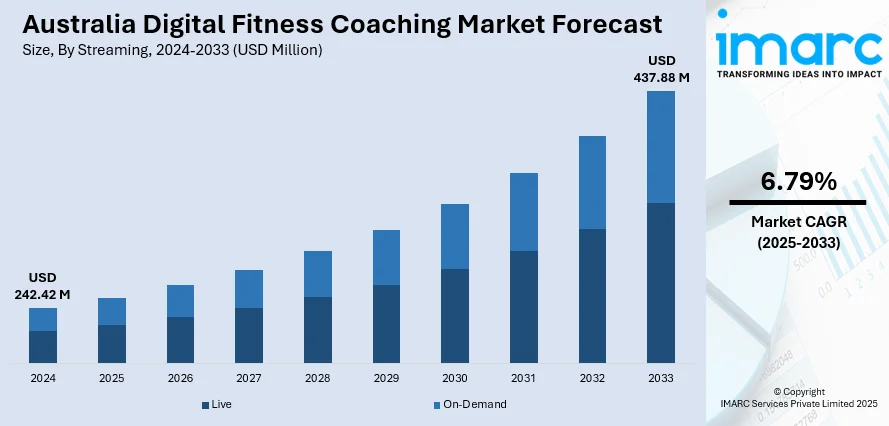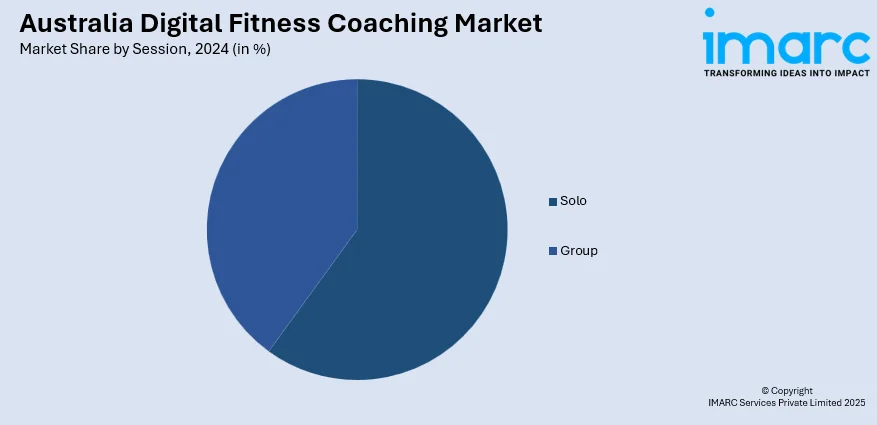
Australia Digital Fitness Coaching Market Size, Share, Trends and Forecast by Streaming, Session, Revenue Model, Device, and Region, 2025-2033
Australia Digital Fitness Coaching Market Overview:
The Australia digital fitness coaching market size reached USD 242.42 Million in 2024. Looking forward, IMARC Group expects the market to reach USD 437.88 Million by 2033, exhibiting a growth rate (CAGR) of 6.79% during 2025-2033. The market is expanding due to increasing health awareness, rising popularity of personalized virtual workouts, and growing integration of AI-driven fitness solutions. Mobile apps and wearable technology are also enhancing user engagement and workout tracking. These trends are significantly shaping consumer behavior and competition in the Australia digital fitness coaching market share.
|
Report Attribute
|
Key Statistics
|
|---|---|
|
Base Year
|
2024 |
|
Forecast Years
|
2025-2033
|
|
Historical Years
|
2019-2024
|
| Market Size in 2024 | USD 242.42 Million |
| Market Forecast in 2033 | USD 437.88 Million |
| Market Growth Rate 2025-2033 | 6.79% |
Australia Digital Fitness Coaching Market Trends:
Growing Health Awareness and Lifestyle Changes
Australians are increasingly prioritizing health and wellness, driven by rising awareness about the long-term benefits of regular physical activity. Many people are turning to flexible and convenient fitness strategies due to their office-based jobs, increased obesity, and changes brought by the pandemic. With digital fitness coaching, people can follow special plans wherever and whenever they want. Many individuals are now using virtual coaching sites to benefit from guidance without having to meet with experts personally. When people focus on self-health at a young and working-age level, it leads to a steady increase in demand for online fitness programs. Because more people care about their mental and physical well-being, there is a growing interest in digital coaching services in Australia.

To get more information on this market, Request Sample
Advancements in Technology and AI Integration
Technological innovation is a core factor driving the Australia digital fitness coaching market growth. The integration of AI, machine learning, and real-time analytics allows platforms to deliver personalized workout plans, adaptive coaching, and progress tracking based on user behavior and biometric data. Wearable devices such as smartwatches and fitness trackers further enhance the experience by syncing seamlessly with coaching platforms, offering insights into sleep, heart rate, calorie expenditure, and more. Voice-guided training, virtual reality workouts, and interactive video sessions also appeal to tech-savvy users. These advancements make digital fitness experiences more interactive and effective, attracting a broader consumer base. As technology continues to evolve, users are increasingly drawn to platforms that offer smart, personalized, and results-driven fitness solutions.
Rise of Influencer and Social Media-Driven Fitness Culture
Social media has played a pivotal role in driving the popularity of digital fitness coaching in Australia. Fitness influencers, athletes, and lifestyle coaches frequently share workout content, nutrition tips, and transformation stories across platforms like Instagram, YouTube, and TikTok, creating a strong sense of community and motivation. Many influencers have launched their own fitness apps and coaching programs, attracting followers who trust their expertise and relatability. This has blurred the lines between entertainment and personal fitness guidance, making digital coaching more aspirational and accessible. The visual and interactive nature of social media also boosts user engagement and brand visibility. As consumers continue to seek inspiration and accountability online, influencer-led fitness coaching platforms are becoming key growth drivers in the market.
Australia Digital Fitness Coaching Market Segmentation:
IMARC Group provides an analysis of the key trends in each segment of the market, along with forecasts at the country and regional levels for 2025-2033. Our report has categorized the market based on streaming, session, revenue model, and device.
Streaming Insights:
- Live
- On-Demand
The report has provided a detailed breakup and analysis of the market based on streaming. This includes live and on-demand.
Session Insights:

- Solo
- Group
A detailed breakup and analysis of the market based on the session have also been provided in the report. This includes solo and group.
Revenue Model Insights:
- Subscription Model
- Pay-Per-Session Model
A detailed breakup and analysis of the market based on the revenue model have also been provided in the report. This includes subscription model and pay-per-session model.
Device Insights:
- Smartphones and Tablets
- Smart TV
- Laptops and Desktops
A detailed breakup and analysis of the market based on the device have also been provided in the report. This includes smartphones and tablets, smart TV, and laptops and desktops.
Regional Insights:
- Australia Capital Territory & New South Wales
- Victoria & Tasmania
- Queensland
- Northern Territory & Southern Australia
- Western Australia
The report has also provided a comprehensive analysis of all the major regional markets, which include Australia Capital Territory & New South Wales, Victoria & Tasmania, Queensland, Northern Territory & Southern Australia, and Western Australia.
Competitive Landscape:
The market research report has also provided a comprehensive analysis of the competitive landscape. Competitive analysis such as market structure, key player positioning, top winning strategies, competitive dashboard, and company evaluation quadrant has been covered in the report. Also, detailed profiles of all major companies have been provided.
Australia Digital Fitness Coaching Market News:
- In November 2023, Coach Welly, an Australian health tech platform established in 2019, partnered with World Gym Australia to provide AI-personalized support and rewards to increase customer satisfaction and loyalty at its network of more than 230 gym locations.
Australia Digital Fitness Coaching Market Report Coverage:
| Report Features | Details |
|---|---|
| Base Year of the Analysis | 2024 |
| Historical Period | 2019-2024 |
| Forecast Period | 2025-2033 |
| Units | Million USD |
| Scope of the Report | Exploration of Historical Trends and Market Outlook, Industry Catalysts and Challenges, Segment-Wise Historical and Future Market Assessment:
|
| Streamings Covered | Live, On-Demand |
| Sessions Covered | Solo, Group |
| Revenue Models Covered | Subscription Model, Pay-Per-Session Model |
| Devices Covered | Smartphones and Tablets, Smart TV, Laptops and Desktops |
| Regions Covered | Australia Capital Territory & New South Wales, Victoria & Tasmania, Queensland, Northern Territory & Southern Australia, Western Australia |
| Customization Scope | 10% Free Customization |
| Post-Sale Analyst Support | 10-12 Weeks |
| Delivery Format | PDF and Excel through Email (We can also provide the editable version of the report in PPT/Word format on special request) |
Key Questions Answered in This Report:
- How has the Australia digital fitness coaching market performed so far and how will it perform in the coming years?
- What is the breakup of the Australia digital fitness coaching market on the basis of streaming?
- What is the breakup of the Australia digital fitness coaching market on the basis of session?
- What is the breakup of the Australia digital fitness coaching market on the basis of revenue model?
- What is the breakup of the Australia digital fitness coaching market on the basis of device?
- What is the breakup of the Australia digital fitness coaching market on the basis of region?
- What are the various stages in the value chain of the Australia digital fitness coaching market?
- What are the key driving factors and challenges in the Australia digital fitness coaching market?
- What is the structure of the Australia digital fitness coaching market and who are the key players?
- What is the degree of competition in the Australia digital fitness coaching market?
Key Benefits for Stakeholders:
- IMARC’s industry report offers a comprehensive quantitative analysis of various market segments, historical and current market trends, market forecasts, and dynamics of the Australia digital fitness coaching market from 2019-2033
- The research report provides the latest information on the market drivers, challenges, and opportunities in the Australia digital fitness coaching market.
- Porter's five forces analysis assist stakeholders in assessing the impact of new entrants, competitive rivalry, supplier power, buyer power, and the threat of substitution. It helps stakeholders to analyze the level of competition within the Australia digital fitness coaching industry and its attractiveness.
- Competitive landscape allows stakeholders to understand their competitive environment and provides an insight into the current positions of key players in the market.
Need more help?
- Speak to our experienced analysts for insights on the current market scenarios.
- Include additional segments and countries to customize the report as per your requirement.
- Gain an unparalleled competitive advantage in your domain by understanding how to utilize the report and positively impacting your operations and revenue.
- For further assistance, please connect with our analysts.
 Request Customization
Request Customization
 Speak to an Analyst
Speak to an Analyst
 Request Brochure
Request Brochure
 Inquire Before Buying
Inquire Before Buying




.webp)




.webp)












